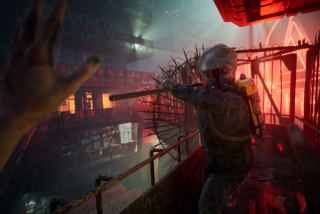Co-Founder Looks at Chaos in Early Stages and Future Challenges
- Share via
Allen Adham, who co-founded Chaos Studios Inc. in Costa Mesa in 1991, sold the video game development business two weeks ago for $6.75 million. In an interview last week with Times staff writer Dean Takahashi, Adham told how he and co-founders Michael Morhaime and Frank Pearce got started and speculated about challenges that the video game industry faces.
Q: How much did you get into video games?
A: In my freshman year in high school, “Space Invaders” and “Asteroids” and “Defender” . . . were just picking up. I used to go (to arcades while) in junior high school and high school at lunch and just fanatically play those games. Then my brother and I talked my dad into buying us (a computer) so we could use it for school. We used it to play games. I liked playing the games so much that I started writing them.
Q: Was it a struggle at first?
A: Early on, it was easy. It was a summer job. I knew a half-dozen people in the business that I could call and ask for work. I could make $12,000 a summer, and that was good money for high school. I would work my own hours, so I had a social life and could go to the beach with my friends. The hard part came when I graduated from college. My attitude was--and this is how I talked Mike and Frank into it--we’re young, we don’t have mortgages or families. All we really have to lose is time. We could try it for a year. If takes off, great. If it doesn’t, chalk it up to experience. . . . I still believe to this day that attitude is everything.
Q: What was the hard part?
A: The biggest single challenge to me was relinquishing control. When there were only three of us, I saw everything and knew everything. Now that there are 19 of us and we’re working on 11 projects, there is no way I can control everything. By nature I am a perfectionist, a workaholic. It’s difficult for me to let go.
Q: As the games get more sophisticated, will it be easier for small U.S. companies to compete with the Japanese, who may not know what the U.S. consumer wants?
A: Sega right now is doing better than Nintendo, because Sega aggressively pursues American cultural properties such as titles like “X-Men” or “Spider Man.” If I could get on the phone and call up the head of Nintendo, I’d tell him to have American companies do more development or have Nintendo of America create its own development so that they could compete on a cultural level. A clear example is our “Rock ‘n’ Roll Racing,” a game we did for Interplay Productions. We came up with a concept that put rock music hand-in-hand with the racing culture. So we said let’s get George Thorogood and the Destroyers’ “Bad to the Bone” and put it in the game. That’s an idea that an American company had to come up with.
Q: Do you fear there will be a trough in sales as everyone waits for the next-generation game system to come out?
A: That is a chicken-and-egg question. There may be a trough where people hold off buying old games. The next year may be a little tight. But the good companies making good games will do just fine. I believe Sega’s next-generation project, the Saturn, will emerge dominant.
Q: There is probably some kind of confusion about what constitutes the video game of the future. What will be state of the art?
A: I can tell you what is state of the art. A lot of games that are hyped as next-generation games now are almost non-interactive. They’re these beautiful showpieces where for the most part you are an interested observer. You don’t really control much of what happens on the screen. You have branching points where you can decide the route the movie plays, but you’re not actually directing it. The future games need to continue to be very interactive, very sweaty palmed, action-oriented.






